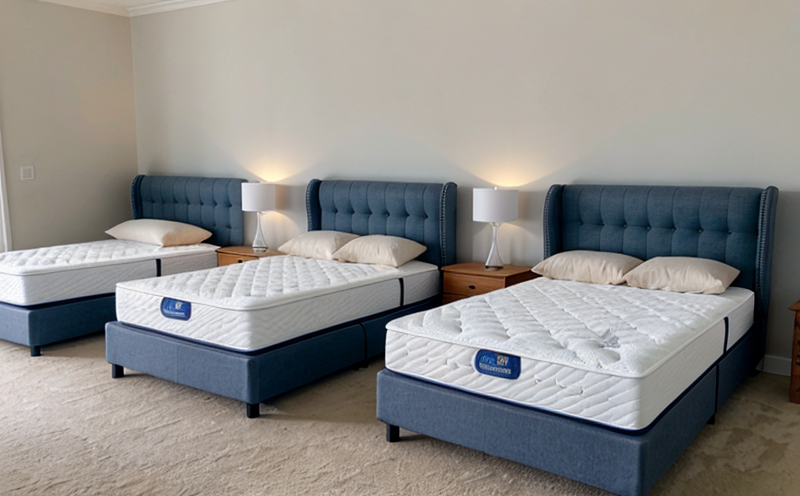ASTM D3575 Flexible Cellular Materials Mattress Pad Cushion Testing
The ASTM D3575 standard is a widely recognized method used to determine the compression properties of flexible cellular materials, such as those found in mattress pads and cushions. This test provides critical data on how these materials perform under pressure, which is essential for ensuring product quality and compliance with industry standards.
The testing process involves compressing a sample of the material to specified depths using a standardized apparatus. The depth to which the specimen is compressed impacts the outcome, as it affects the perceived firmness of the mattress pad or cushion. Compliance officers and R&D engineers rely on this data to ensure that their products meet customer expectations and regulatory requirements.
The testing procedure can also help quality managers identify potential issues in production processes by providing insights into material consistency. By regularly monitoring these parameters, manufacturers can improve product performance and reduce the risk of defects reaching the consumer market.
The ASTM D3575 test is particularly relevant for beds and mattresses where comfort and support are paramount. It ensures that consumers receive products that meet their expectations regarding firmness and resilience. This testing method is not only useful in manufacturing but also during quality control to ensure each product meets the necessary standards.
For procurement teams, this standard provides a clear benchmark against which materials can be evaluated. By specifying compliance with ASTM D3575 as part of their procurement criteria, organizations can ensure that they are sourcing high-quality materials from reputable suppliers.
Test Procedure
The test is conducted using a compression testing machine that applies pressure to the sample according to specified parameters outlined in the standard. The specimen is placed between two platens, one of which moves vertically and applies compressive force. The depth at which the material is compressed is measured accurately.
- The initial compression load is typically applied until the material reaches a specific percentage of its original thickness.
- Data is collected on the force required to achieve this compression, as well as the resulting deformation.
The data obtained from these tests can be used in various ways. Quality managers may use it to refine manufacturing processes or improve product design. Compliance officers ensure that products meet all relevant standards and regulations. R&D engineers can leverage the insights gained from these tests to innovate new materials and designs.
Specimen Preparation
The preparation of the specimen is critical for accurate testing results. Samples must be cut to a standard size, typically 150 mm x 150 mm, according to ASTM D3575 guidelines. The sample should also be conditioned to ensure it reaches equilibrium moisture content before testing.
Conditioning involves storing the specimen in an environment that matches the expected service conditions for a specified period. This ensures that any variations due to humidity or temperature are minimized, leading to more reliable test results.
Instrumentation and Reporting
The ASTM D3575 standard specifies the use of a compression testing machine equipped with appropriate sensors and software to record force and displacement data accurately. The equipment must be calibrated regularly to maintain precision.
After conducting the tests, detailed reports are generated summarizing the test results. These reports include key parameters such as peak load, deflection at peak load, and percentage of original thickness after compression. Compliance officers use these reports to verify that products meet required standards and regulations.
Industry Applications
| Application Area | Description |
|---|---|
| Beds and Mattresses Manufacturing | Ensure consistent quality in mattress pads and cushions by measuring compression properties. |
| Quality Control | Detect inconsistencies in production processes to improve product performance. |
| Compliance with Standards | Verify that products meet regulatory requirements and industry standards. |
| R&D Innovation | Develop new materials and designs by analyzing test data to refine product specifications. |
| Supplier Evaluation | Evaluate the quality of raw materials sourced for manufacturing processes. |
- Beds and Mattresses Manufacturing: Ensuring that mattress pads and cushions meet customer expectations regarding comfort and support.
- Quality Control: Detecting inconsistencies in production to maintain high standards of quality.
- Compliance with Standards: Meeting regulatory requirements and industry benchmarks for product performance.
International Acceptance and Recognition
The ASTM D3575 standard is internationally recognized, ensuring that the results of mattress pad cushion testing are consistent across different regions. This recognition facilitates global trade by providing a common language for quality assessment.
American laboratories, in particular, play a significant role in upholding these standards. Their expertise ensures accurate and reliable test results, which are crucial for maintaining trust within the industry.
By adhering to ASTM D3575, manufacturers can ensure that their products meet international quality benchmarks. This standardization is vital for expanding markets and building strong brand reputation globally.
Environmental and Sustainability Contributions
- Eco-friendly Materials: By ensuring that mattress pads and cushions meet stringent compression property standards, manufacturers can select eco-friendly materials that reduce environmental impact.
- Resource Efficiency: Accurate testing helps in optimizing material usage, reducing waste during production processes.
The ASTM D3575 standard contributes to sustainable practices by promoting the use of high-quality, durable materials. This not only reduces the need for frequent replacements but also minimizes environmental footprint through extended product lifecycle.
Testing Benefits for Sustainability
Compliance with ASTM D3575 ensures that mattress pads and cushions are made from sustainable resources. By adhering to this standard, manufacturers can demonstrate their commitment to environmental stewardship, which is increasingly important in today’s market.





